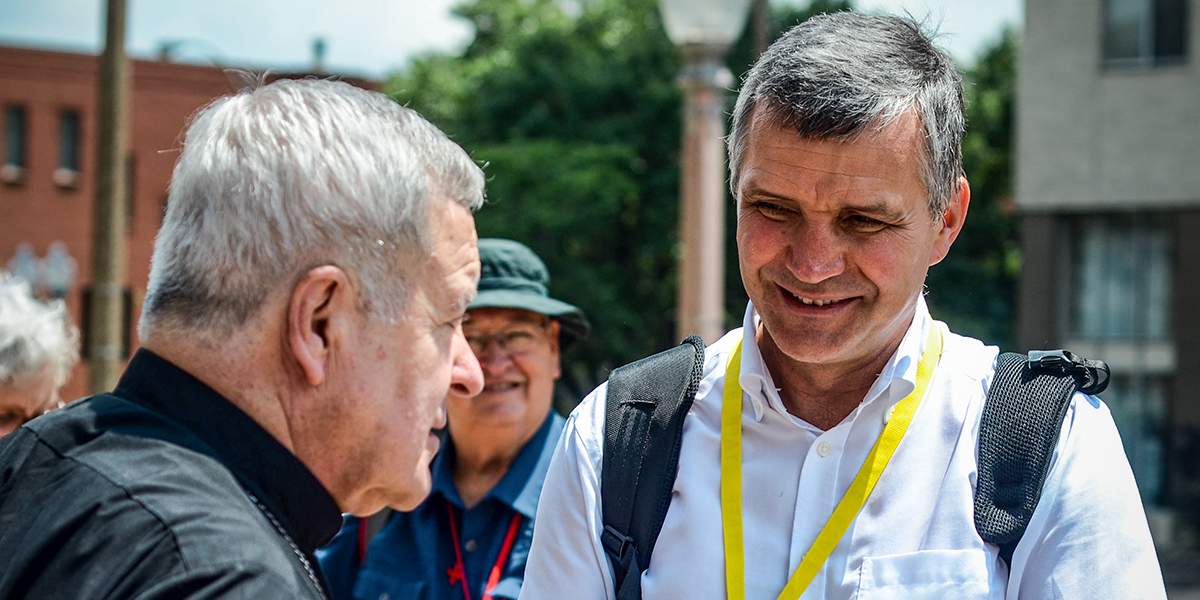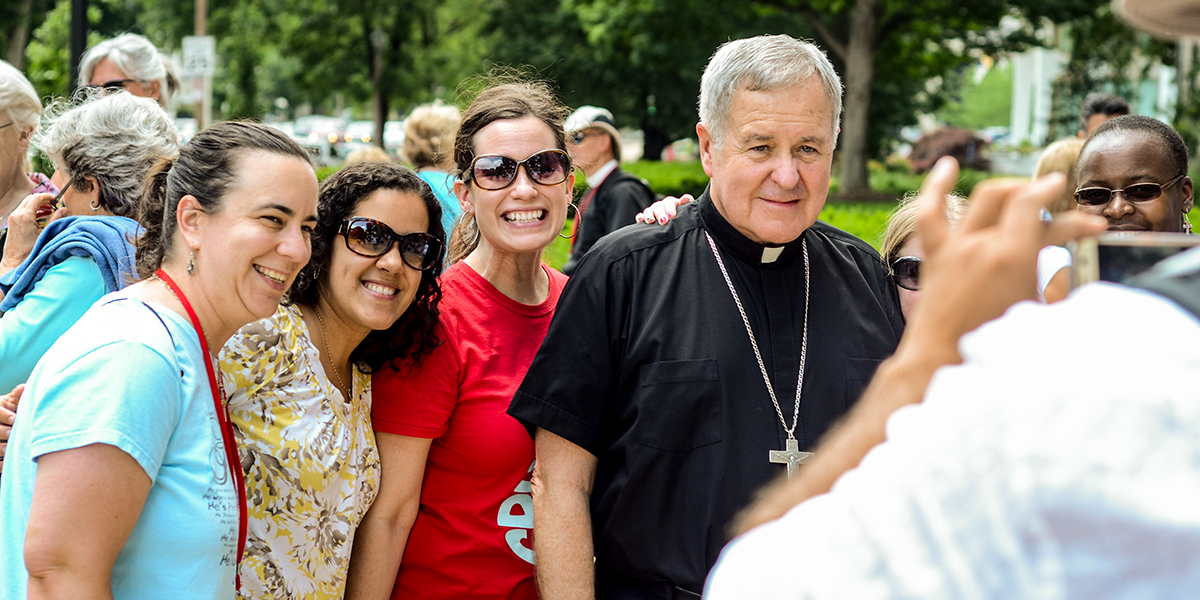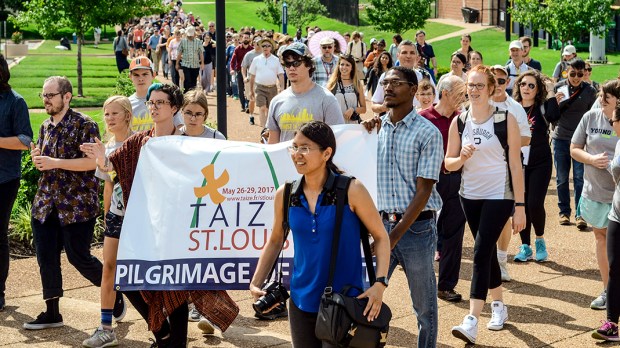After Ferguson, after Mizzou, after the 2016 election, after everything, what would it take to gather together the white and black communities of St. Louis for prayer?
A couple of monks from France?
That’s what Archbishop Robert Carlson thought the answer might be, and by most accounts, he was right.

Over Memorial Day weekend, hundreds of people responded to the call of the brothers of Taizé and the St. Louis Archdiocese to join them on a “pilgrimage of trust.” Pilgrims from near and far gathered on the campus of Saint Louis University to pray together in the style of the ecumenical Taizé Community, to reflect on the barriers created by fear, and to participate in a Walk of Trust through a city rent by racial division.
The climax of the meeting came on Sunday with the Walk of Trust — a new development for Taizé meetings, which happen in the U.S. annually in different cities. At the end of the walk, a crowd gathered at SLU’s Chaifetz Arena where Archbishop Carlson addressed participants alongside the Rev. Dr. Traci Blackmon, a pastor and nationally renowned leader in social justice circles.
Blackmon and Carlson both agreed that the pilgrimage of trust represented a new beginning for St. Louis. Carlson illustrated this with a story from one of the preliminary “evenings of trust” that was held prior to Memorial Day weekend.
“A white man from St. Charles drove to a church in Ferguson, not sure what to expect,” Carlson said. “And after the prayer, during the discussion portion of the evening, he admitted to his table that he was uncomfortable being there.” The man, Carlson explained, was fearful for his own safety.
“At that moment, an elderly African-American woman at the table said to him, ‘That’s exactly how I feel when I drive to the store and walk in St. Charles. I’m not comfortable, and I never know what to expect.’” This, Carlson said, represented a positive step. “Through the grace of the earlier prayer and the trust that developed, barriers were removed between them, and a new understanding was formed.”

This small sign of racial healing comes nearly three years after Ferguson. And Carlson and Blackmon spoke in the same arena where, just after Michael Brown died, a crowd reacted angrily to calls for unity and staged a sit-in on the campus of SLU. Why were things so different this time around?
Part of the reason that the St. Louis pilgrimage of trust was successful, Carlson mused, was timing.
“We’re far enough away from Ferguson now that we can begin to look at it more objectively rather than emotionally,” Carlson told Aleteia. But more than just the passage of time, Carlson credits the work of God through the prayers led by the Taizé brothers.
“Even if this is a small beginning, it’s growing, and we can begin to confront — in a healthy way — our differences, but to confront them with love because that’s what the Lord gives us to reach out to each other,” he said. “Of course, with the presence of the brothers, it was peaceful, beautiful music that I believe opens the heart to the Holy Spirit.”
The musical prayers of Taizé, repetitive and melodic chants, are
. But Carlson chose to invite the brothers for a different reason, dating back to his tenure in South Dakota.“This time it was very unusual for us,” said Brother John of Taizé, one of the organizers of the meeting. They had never received such a direct invitation from a Catholic bishop in the United States before. “Archbishop Carlson had been the bishop of Sioux Falls once upon a time in South Dakota. And he heard about a meeting we had on the Pine Ridge Indian reservation three years ago when we were welcomed by the Native Americans, and that really spoke to him.” The bridging of ethnic divisions struck a chord with Carlson.
“This was just after Ferguson. So he said, we really need something like this here: a pilgrimage of trust in St. Louis.”
The time immediately after Michael Brown’s death was very fraught, “certainly a time with great tension, and I felt it myself, even towards me,” Carlson told Aleteia. Even before that, he said that he had tried—unsuccessfully—to organize events to bring together people of different races.
“Well, there was a wall,” Carlson explained. “It was an invisible wall, it was a wall of fear and indifference maybe.”
But something about the brothers of Taizé, and their unique approach to bringing people together, helped propel forward the cause of unity over Memorial Day weekend.
“The truth is, ultimately, we need reconciliation,” Carlson said in his address at Chaifetz Arena. “And I believe that this is one of the greatest charisms of the Taizé Community. It is one of the reasons why in prayer, the Lord led me to invite them.”
Taizé, which is a community of both Protestant and Catholic monks, has long worked for reconciliation across denominational as well as ethnic lines. One of the keys to doing it well, according to Brother John, is not to act like an expert.
“We’ve really gone out of our way to say we certainly don’t have all the answers,” he told Aleteia. But neither are the brothers coy about sharing their vision for what is necessary for healing to take place. Brother John insisted that systemic and structural change will be critical to dealing with the divisions in St. Louis, but he also said that it requires more than that.
“We’ve met a couple of activists in the beginning who didn’t really get it,” he said. “I think they didn’t always understand that if you just try to impose or just get people to vote a certain way, in the long run, is it really going to change anything in a meaningful way? You need to bring people along. And that’s what the hope is here—that you bring people along.”
The racial and religious dynamics of St. Louis—most of the city’s Catholics are white, while most of the black Christians are Protestant—required the inclusive approach that Taizé is famous for. Archbishop Carlson also thought this was necessary, and appreciated it.
“Somebody talked about ‘it takes a village to raise a child’ years ago,” Carlson told Aleteia. “I think it takes all the churches working together to make Christ present in the community. That’s why ecumenism is so important.”

